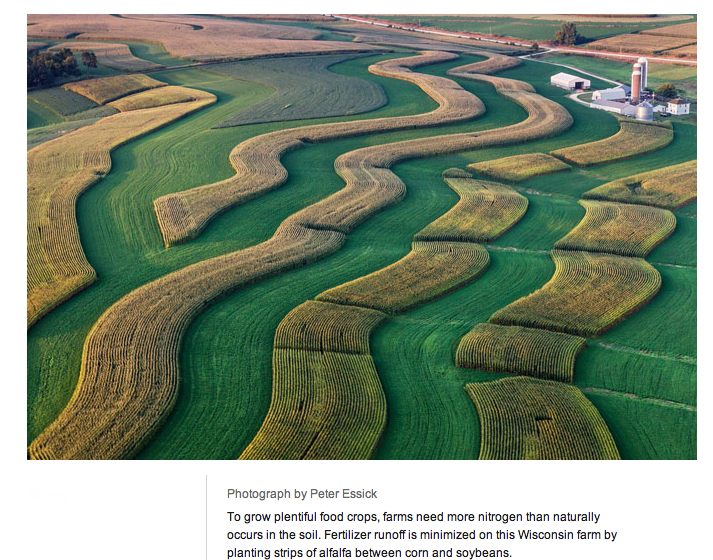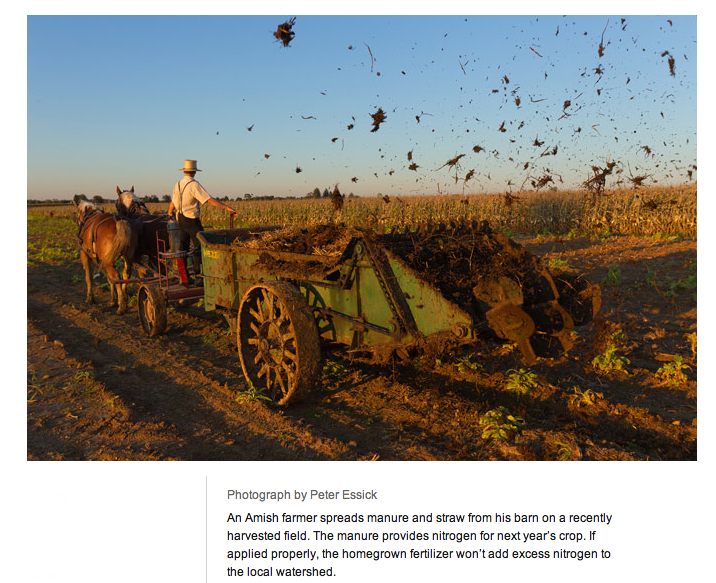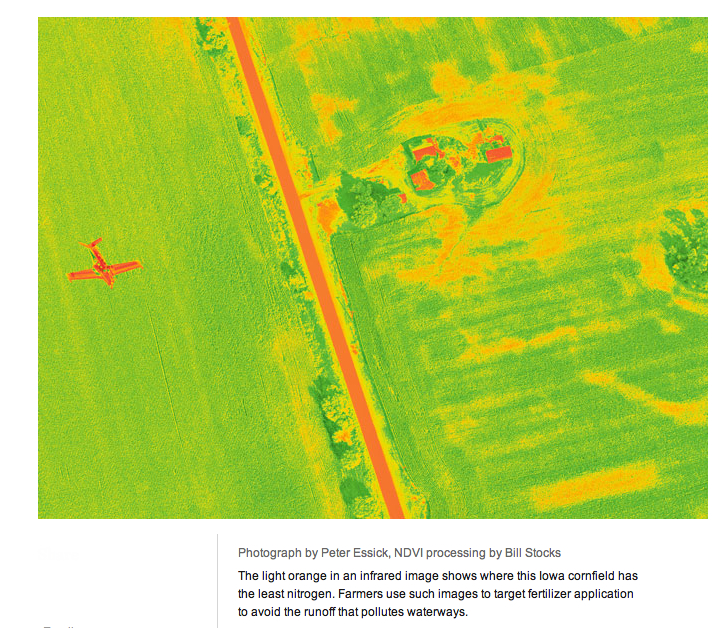Nitrogen
in our modern fertilized world
By Dan Charles
Originally Published in National Geographic in
the May 2013 issue.
If we don’t watch out, agriculture could destroy our
planet. Here’s how to grow all the food we need with fewer chemicals.

N.
Nitrogen. Atomic number seven.
Unnoticed, untasted, it nevertheless fills our stomachs. It is the engine of
agriculture, the key to plenty in our crowded, hungry world.
Without
this independent-minded element, disinclined to associate with other gases, the
machinery of photosynthesis cannot function—no protein can form, and no
plant can grow. Corn, wheat, and rice, the fast-growing crops on which humanity
depends for survival, are among the most nitrogen hungry of all plants. They
demand more, in fact, than nature alone can provide.
Enter
modern chemistry. Giant factories capture inert nitrogen gas from the vast
stores in our atmosphere and force it into a chemical union with the hydrogen
in natural gas, creating the reactive compounds that plants crave. That
nitrogen fertilizer—more than a hundred million tons applied worldwide
every year—fuels bountiful harvests. Without it, human civilization in
its current form could not exist. Our planet’s soil simply could not grow
enough food to provide all seven billion of us our accustomed diet. In fact,
almost half of the nitrogen found in our bodies’ muscle and organ tissue
started out in a fertilizer factory.

Yet
this modern miracle exacts a price. Runaway nitrogen is suffocating wildlife in
lakes and estuaries, contaminating groundwater, and even warming the globe’s
climate. As a hungry world looks ahead to billions more mouths needing
nitrogen-rich protein, how much clean water and air will survive our demand for
fertile fields?
The
nitrogen dilemma is most starkly visible in China, a country that loves its
food and worries that supplies might run out. To the casual visitor, that
anxiety seems misplaced. There’s a feast, it seems, on every street. In a
restaurant called San Geng Bi Feng Gang, on the outskirts of Nanjing, I watch
with wonder as dishes parade by: steamed fish, fried mutton chops,
chrysanthemum-leaf-and-egg soup, a noodle dish made from sweet potatoes, fried
broccoli, Chinese yams, steaming bowls of rice.
“Did
you always eat this well?” I ask Liu Tianlong, an agricultural scientist who’s
introducing me to farmers nearby.
His
boyish smile fades, and for a second he looks grim. “No,” he says. “When I was
young, you were lucky to get three bowls of rice.”
Liu
grew up in the aftermath of China’s great famine, which lasted from 1959 to
1961 and killed an estimated 30 million people. Drought played a part, but the
catastrophe was inflicted mainly by the whims of Chairman Mao. The Chinese
leader’s Great Leap Forward collectivized farming and forced peasants to turn
their harvests over to a centralized bureaucracy.
The
famine passed, but scarcity continued until the late 1970s, when farmers
regained control of their own harvests. “Within two years, almost overnight,
food was in surplus,” recalls Deli Chen, who witnessed those reforms as a boy
in a small rice-growing village in Jiangsu Province. Chen is now a soil
scientist at the University of Melbourne in Australia.
Yet
China’s newly entrepreneurial farmers ran into another barrier: the limits of
their land. As the country’s population grew by an astounding 300 million
people between 1970 and 1990, China’s traditional agriculture struggled to keep
up.
Song
Linyuan, an elderly but spry farmer in a village northwest of Nanjing, recalls
how he once kept his 1.3 acres of cropland as fertile as possible, composting
household waste and spreading manure from his pigs and chickens. In all, his
efforts added perhaps a hundred pounds of nitrogen per acre of land each year.
He harvested 2,600 to 3,300 pounds of rice per acre.
That’s
a respectable harvest, a better yield than in many parts of the world. But now
he gets more than twice that: 7,200 pounds per acre. It’s a harvest many
farmers can only dream of.
The
difference? “Better fertilizer,” he says. We’re sitting in a shop surrounded by
farmers. Song’s answer provokes a loud discussion. Some agree that fertilizer
was key; others say better seeds were more important. In reality the two technologies
are intertwined. The high-yielding varieties of rice and wheat that breeders
created in the 1950s and 1960s could reach their full potential only if they
got more nitrogen.
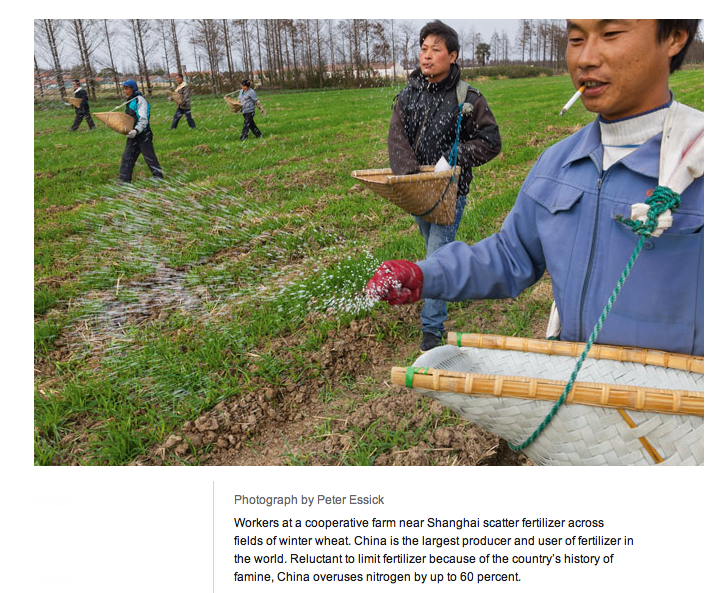
The
Chinese government made sure those crops were well
fed. Between 1975 and 1995 it built hundreds of nitrogen factories, quadrupling
the country’s manufacture of fertilizer and turning China into the world’s
biggest producer. Song now spreads about five times as much nitrogen as before,
saturating his fields with urea—a dry form of nitrogen—by casting
handfuls of the snow-white granules across green shoots. This adds up to 530
pounds of nitrogen per acre. Farmers who grow vegetables use even more; some
spread a ton of nitrogen, or even two, on each hectare (2.47 acres). Few of
them think they’re doing anything harmful. “No, no pollution,” says Song, when
asked about the environmental effects of fertilizer.
Scientists
tell a different story. “Nitrogen fertilizer is overused by 30 to 60 percent”
in intensively managed fields, says Xiaotang Ju, of the China Agricultural
University in Beijing. “It’s misuse!” Once spread on fields, nitrogen compounds
cascade through the environment, altering our world, often in unwelcome ways.
Some of the nitrogen washes directly from fields into streams or escapes into
the air. Some is eaten, in the form of grain, by either humans or farm animals,
but is then released back into the environment as sewage or manure from the
world’s growing number of pig and chicken farms.
Deli
Chen recalls catching fish as a boy. “The river was so clean. You could see
right through it,” he says. By 1980 “you couldn’t see the fish anymore.” The
cloudiness came in part from proliferating phytoplankton, a symptom of water
that’s eutrophic, or overloaded with nutrients. A recent national survey of 40
lakes in China found that more than half of them suffered from too much
nitrogen or phosphorus. (Fertilizer containing phosphorus is often to blame for
algal growth in lakes.) The best known case is Lake
Tai, China’s third largest freshwater lake, which regularly experiences huge
blooms of toxic cyanobacteria. A spreading bloom in 2007 contaminated water
supplies for two million people in the nearby city of Wuxi. Excess nutrients
are damaging fisheries in China’s coastal areas in the same way that fertilizer
runoff flowing down the Mississippi has destroyed fisheries in the Gulf of
Mexico: by creating dead zones in which algae and phytoplankton bloom, die, and
decompose, using up oxygen and suffocating fish.
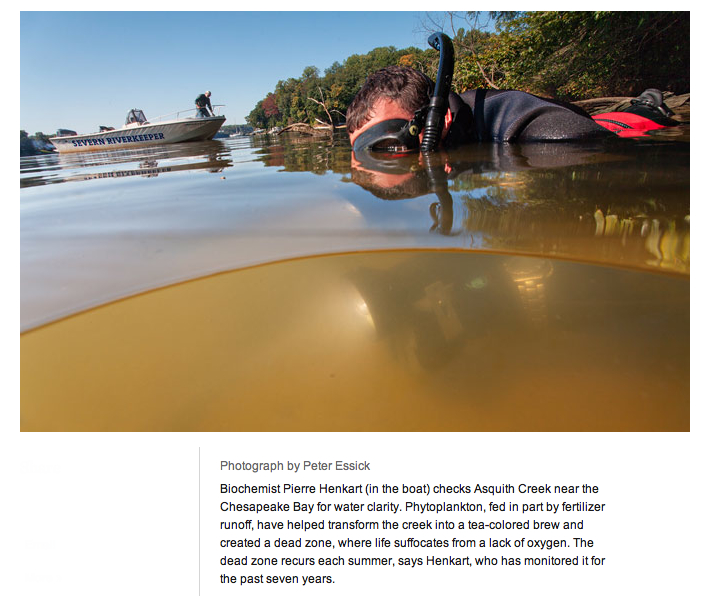
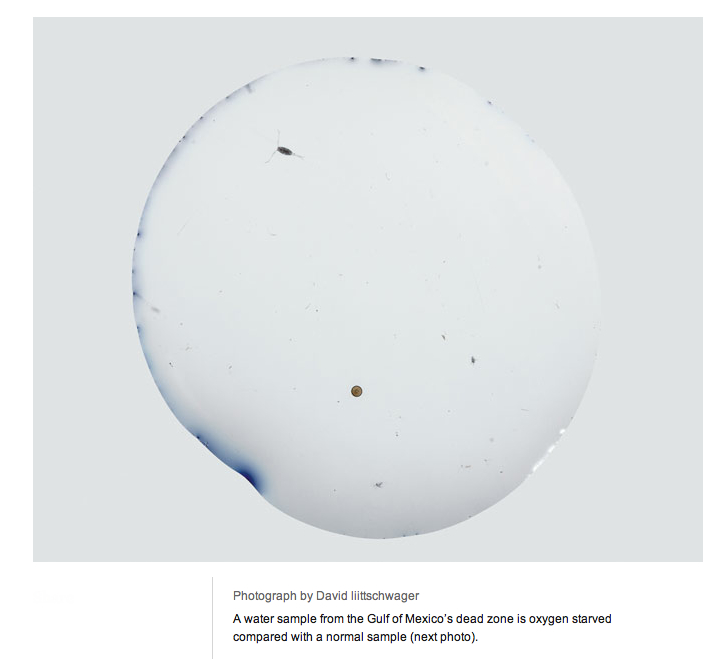

Our
demand for food, to be sure, isn’t solely to blame. The combustion that drives
cars and electric generators releases nitrogen oxides into the atmosphere, and
when those compounds return to Earth in drops of rain, they also act as
fertilizer. (This accounts for about a quarter of the nitrogen load in Lake
Tai.) But worldwide, commercial fertilizer adds up to 70 percent of the
nitrogen that human activity produces every year.
Nitrate-eating
bacteria in the soil can convert these disruptive forms of nitrogen back to the
original, environmentally benign source that makes up nearly 80 percent of our
atmosphere. But even this process is a mixed blessing, as the bacteria also
release small amounts of nitrous oxide, a powerful greenhouse gas. “To solve
this nutrient-overload problem, it is my dream,” says Xiaotang Ju, who is part
of China’s “nitrogen family,” a loose network of scientists devoted to this
herculean task. The patriarch of the cause, Zhu Zhaoliang, startled a
conference of China’s ruling party in 1998 with a lecture about the dangers of
agricultural pollution. China’s president at the time, Jiang Zemin, responded
that he didn’t realize agriculture could pollute so seriously.
These
scientists have begun working with small groups of farmers, showing them that
less fertilizer doesn’t shrink their harvests and can actually fatten their
wallets. They’re promoting the use of compost and teaching farmers to apply
synthetic fertilizer when and where the plants actually need it. But they admit
they’ve made little progress. The biggest obstacle is that most Chinese farmers
are part-time. They aren’t interested in saving a few yuan by cutting back on
fertilizer. It’s more important to save time and keep their city jobs, so they
apply fertilizer quickly but inefficiently.
And
fear of food scarcity still haunts the Chinese imagination, outweighing
concerns about the environment. Huang Jikun, director of the Center for Chinese
Agricultural Policy, frequently tries to convince government officials that
their worries are misplaced. “I tell them, China is more food secure than it
has been for 5,000 years!” he says. But for officials and farmers alike,
applying less fertilizer seems like tempting fate, risking a disastrous
shortfall.
It’s
likely that China—and the rest of the world—will use more nitrogen
in the years to come, not less. Populations continue to expand, and meat is
growing more popular. Feeding pigs or cattle demands several times more
agricultural production than does using that grain to directly nourish people. “If
Chinese change their diet to be like yours [in the West], the environmental
pressure will be very high,” says Xiaotang Ju somberly. “We have to tend to
this problem. Otherwise it will be really big.”
There’s
a glimpse of a solution on a farm just
outside the small town of Harlan in western Iowa. Here 90 cattle graze on green
pasture, and a few hundred pigs root about in beds of straw, surrounded by
fields of alfalfa, corn, soybeans, oats, and barley.
Ron
and Maria Rosmann spread no nitrogen fertilizer on these fields, at least not
the kind that comes from factories. Instead, it’s added biologically, by
nitrogen-fixing bacteria that live in nodules on the roots of legume crops like
soybeans, alfalfa, and a cover crop of clover that Ron Rosmann plants in the
fall, only to till it back into the soil before he plants corn in the spring.
Some of that nitrogen is captured in the corn, which he feeds to the pigs. Most
of that ends up in manure, which goes back onto his fields, and the cycle
starts all over again. Rosmann, unlike many other organic farmers, doesn’t buy
manure from neighbors.
“One
of our goals has been to maintain a closed system,” he says. “We are a model for what organic farming
should be like.”
We
wade into one cornfield. The stalks tower over our heads. “Look at this corn,”
Rosmann exults. “We could have 200-bushel corn right here. A lot of naysayers
will say, You organic guys can’t feed the world. I
say, That’s not true. Look at this crop!”
Yet
Rosmann’s methods carry their own cost. Farming this way takes more work, for
one thing. And biology works more slowly than a nitrogen factory. The crops
that build up the soil’s store of nitrogen, like alfalfa, don’t bring in as
much money, or feed as many people, as nitrogen-hungry corn.
That’s
not necessarily a problem for North America. The United States, with six times
as much arable land per person as China, has the luxury of planting
less-productive crops that protect the environment, if people are willing to
pay for them. That setup works for Rosmann; he gets a small payment from the
government, part of an environmental subsidy program, and sells his organic
crops for premium prices.
But
will everyone pay those prices? Could his methods feed the world’s most populous
country? Zhu Zhaoliang, in his office at the Institute of Soil Science in
Nanjing, laughs out loud at the question. “Organic farming is not a solution
for China,” he says flatly.
Yet
there may be a middle ground—excellent harvests with reduced nitrogen pollution—and
some of the world’s most intensely studied fields are pointing the way toward
it. Those fields, each exactly a hectare in size, are part of Michigan State
University’s Kellogg Biological Station, near Kalamazoo. For 20 years these
fields have been growing corn, soybeans, and wheat in exactly the same rhythm,
providing a side-by-side comparison of four different ways to farm, ranging
from mainstream to organic. Everything that enters or leaves the fields is
carefully measured: rainfall, fertilizer, nitrous oxide
emitted from the soil, water that leaches into groundwater, and finally
the harvest.
Michigan
State’s Phil Robertson, who helped set up this long-running experiment, takes
me on a tour of the fields. He’s itching to reveal some new and “quite amazing”
data. Each field planted according to standard plowing and fertilizer
recommendations released 610 pounds of nitrogen per acre into Michigan’s
shallow groundwater over the past 11 years. “So about half of the fertilizer
that’s added we lose,” Robertson says. This loss is much less than what’s
common in China. Yet when multiplied by tens of millions of acres of American
cropland, it’s enough to produce polluted groundwater, a nutrient-loaded
Mississippi River, and an enormous dead zone in the Gulf of Mexico.
The
organic fields in Robertson’s experiment, which received no commercial
fertilizer or manure, lost only a third as much—but those fields also
produced 20 percent less grain. Intriguingly, the “low input” fields, which
received small amounts of fertilizer but were also planted with winter cover
crops, offered the best of both worlds: Average yields were about as high as
those from the conventional fields, but nitrogen leaching was much reduced,
almost to the level of the organic fields. If America’s farmers could cut their
nitrogen losses to something close to this level, Robertson thinks, restored
wetlands and revived small streams could clean up the rest. As in China,
though, many farmers find it hard to change. When a family’s livelihood is at
stake, it may seem safer to apply too much fertilizer rather than too little. “Being
a good steward currently has economic consequences that are unfair,” says
Robertson.
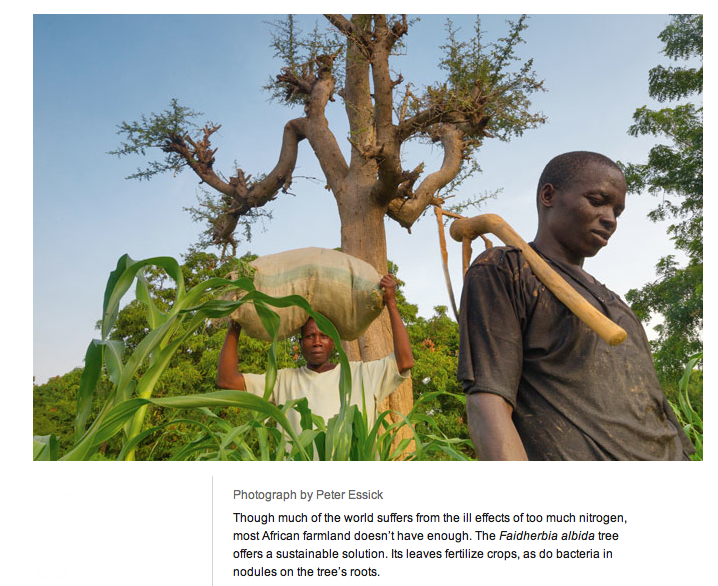
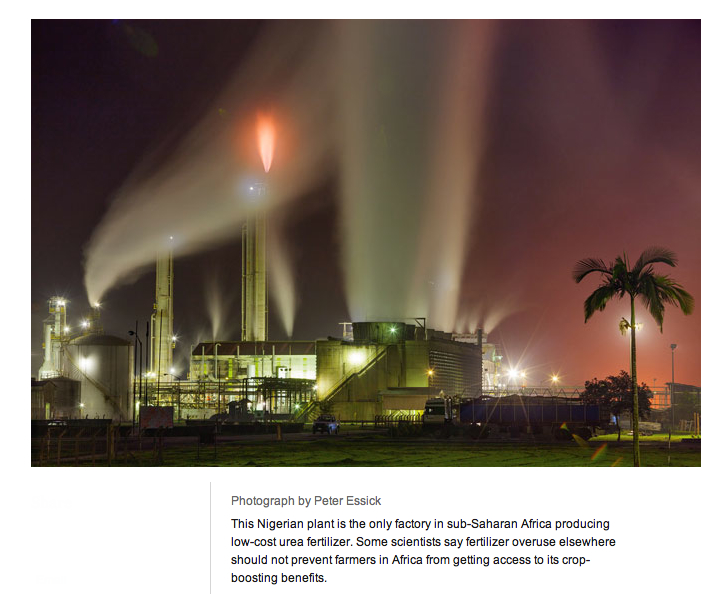
Viewed
from Africa, the problem of overusing
commercial fertilizer seems like a luxury. African farmers use meager
quantities of the stuff—just seven pounds per acre on average.
Alternative sources, such as manure or legume crops, are scarce as well.
Many
in Africa’s rural villages have fallen into a set of vicious circles. Fearing hunger,
they concentrate on crops like rice or corn that deliver maximum calories but
that tend to strip nutrients from the soil. Depleted
land delivers increasingly poor harvests, leaving farmers too financially
strapped to afford fertilizer, from whatever source. And since there is little
demand for commercial fertilizer, no one makes it locally, so it’s imported and
expensive.
According
to many experts, African soils are being mined. The natural reservoirs of
fertility—nutrients stored in the organic matter of decomposing roots and
leaves from previous centuries—are shrinking as farming extracts more
nitrogen, phosphorus, and potassium every year than it replaces. This leaves
the land progressively less able to feed the people who depend on it—“a
scenario for disaster over the long run,” according to the World Bank.
The
average grain yield in sub-Saharan Africa is about 900 pounds per acre, just
one-fifth the average in China. Nearly everyone who’s looked at the situation
agrees: African farmers need more nitrogen to improve their harvests and their
lives. But there’s a raging, bitter debate over where they should get it.
Some,
like Jeffrey Sachs at Columbia University’s Earth Institute, believe that
increasing agricultural production demands more commercial fertilizer, and if
poor African farmers can’t afford it, then wealthier nations should provide it.
In 80 villages across ten different African countries, Sachs’s Millennium
Villages Project passes out bags of improved seeds and fertilizer. And the project’s having a big impact, according to its own data. In
the millennium villages of Tanzania, Kenya, and Malawi, grain production
doubled almost immediately.
In
2006 the government of Malawi started providing cheap fertilizer to about half
the nation’s farmers. Production of corn doubled—although good rains get
much of the credit. These programs, however, are haunted by doubts about the
future. Fertilizer subsidies were tried in many African countries during the
1970s and 1980s but fell out of favor because they were expensive and plagued
by corruption. Malawi’s current subsidy program is already in trouble: The
government is running out of money to pay for it.
“Africa
cannot afford massive amounts of fertilizer,” says Sieglinde Snapp, a crop
scientist at Michigan State University. A more sustainable approach, she says,
is greater reliance on nitrogen-fixing plants. Thousands of farm families in
Malawi have begun growing nitrogen-adding pigeon peas and peanuts on their
land, replacing some of their corn. It’s part of a ten-year-old experiment
begun by local hospitals, farmers, and agricultural researchers.
Because
peas made the soil more fertile, the next season’s corn harvest was larger—more
than making up for the fact that less land was being planted with corn. “Less
corn is more corn,” says Snapp. Plus that bonus crop of pigeon peas provided
more nutritious, protein-rich meals. “But it didn’t happen overnight,” says
Snapp. “It took education on how to use the legumes. It was 20 years of work,
with a hospital involved. People changed their recipes.”
Snapp’s observation—that acquiring and conserving
nitrogen in the future will take considerable know-how and patience—is
echoed by many people engaged in this worldwide quest. Asked what Chinese agriculture needs most, soil
scientist Zhu Zhaoliang responds quickly, “More scale”—meaning larger,
more skillfully managed farms. Ron Rosmann, in Iowa, explains that farming
without added nitrogen “takes more management, more labor, more attention to
detail. We’re kind of fanatics.”
A
century ago, when chemist Fritz Haber first learned how to capture nitrogen
from the air, synthetic fertilizer seemed like an easy shortcut out of
scarcity, delivering a limitless supply of agriculture’s most important
nutrient. Yet new limits on nitrogen are appearing. This time the innovations
that save us—and our planet—may not be invented in a chemistry
laboratory. Instead they may come from farmers and fields in every corner of
the world.
